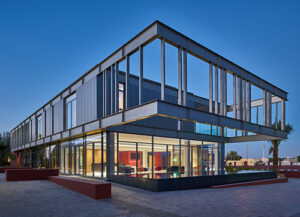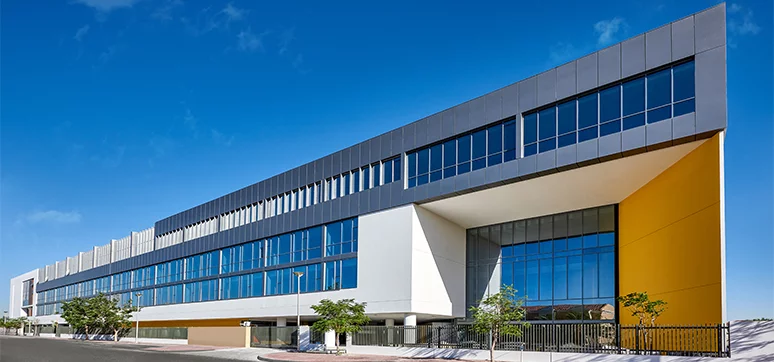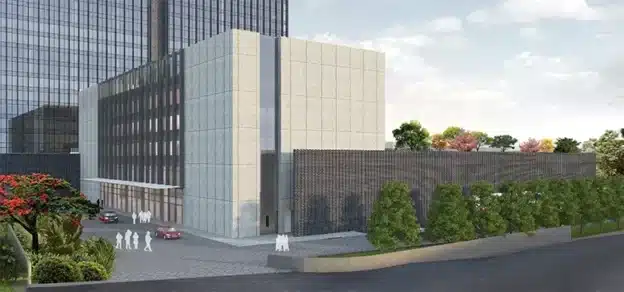The use of glass for a building façade has long been a preferred cladding for designers as a way of opening up the space and bringing the exterior inside. Glazing helps provide the necessary daylight inside a building and brings the heat into the built form. It also adds to the aesthetics and helps reduce the maintenance costs. All buildings have elements such as doors, windows, and skylights where glass is used as infills with metal or UPVC profiles. Glass today has become a lot more specialised with enhanced technical and performance capabilities that require specialist knowledge. The performance of the glass affects the ingress of heat and light so it is important to use the correct glass for the building depending on the usage and energy efficiency required.
The glass comes in pure sheets which are called float glass as the process of manufacturing includes floating the molten glass on molten tin or similar materials. Float glass is a very basic component of glazing used in buildings. It can be used in the form of insulated glass or double glass units (DGUs). Double glass units are the common form of insulated glass where two glass panels are combined with an air gap to create a double glazed panel. Depending on the performance specified the glass processor builds the DGUs where individual float glass panels are toughened, coated, and tinted before being fused together. As general protocols, these are tested and the test reports are reviewed before the actual fabrication.
Architects will look at the light transmission and U-value as well as the shading coefficient as key basic performance factors. In this region, in particular, UV transmission and the light to solar is an important consideration to counteract the building’s solar heat gain. Reflectivity and the colour of the glass are purely aesthetic and will depend on the client’s brief. Light transmission is usually specified in percentages and indicates the amount of transparency of the glass. This value is decided depending on the building usage. A retail unit, for example, will require more transparency and so the figures are closer to 80-90%. For residential buildings where comfort and less glare are required, the value would be around 40-50% transmittance. The lower the transmittance the darker the glass appears.
The U-value is one of the main criteria which indicates the thermal performance of the glass. This is usually measured in w/m2 which is the amount of energy that will pass through a 1 m2 area of a substance for each degree of temperature difference from one side to the other. Generally, municipalities across the world stipulate this figure, which is an average of DGU and the profile system. In Dubai, the green building guidelines define this based on the surface area of the glass compared to the overall façade area.
The shading coefficient (SC) is a measure of the heat gain through the glass from solar radiation. Specifically, the SC is the ratio between the solar heat gain for a particular type of glass and that of double-strength clear glass. A lower shading coefficient indicates a lower solar heat gain. Architectural glass has come a long way in becoming one of the premier materials preferred by architects and designers and modern innovations have provided more options for designers allowing us to continue to meet the needs of building owners and developers today and in the future.
CASE 1: The Arcadia School Seconadary Campus, Dubai

High-performance glass is used in this project with flexible design. When modelling for the façade, we designed the glass to take into account the solar gain on the western and southern side of the building rather than simply using a generic glass cladding for the entire building.
Fact File
Client: Arcadia Academy
Location: Dubai
Architects: Godwin Austen Johnson
Materials: High-performance glazing
Date of start and completion: July 2018 – July 2020
CASE 2: Office Project, Abu Dhabi

For this project, the ceramic fritted glass has been used which cuts the glare and adds to the overall solar heat gain criteria yet still maintains the transparency effect.
Fact File
Project type: Office
Materials: High-performance glazing with a ceramic fritting for skylights
Architects: Godwin Austen Johnson
Date of start and completion: Ongoing
CASE 3: Dubai Sports City Sports Academics

A large part of the façade design of the Dubai Sports City was made up of high-performance glass, but to further offset the solar gains and cut off the glares, we used glulam columns with aluminium aerofoils. Glulam is a sustainable material that helps reduce a building’s footprint by reducing energy usage.
Fact File
Project type: Sports facility
Client: Dubai Sports City
Location: Dubai
Architects: Godwin Austen Johnson
Materials: High-performance glazing with aerofoil devices
Date of start and completion: July 2006 – July 2008
CASE 4: Serenia Residences, The Palm Jumeirah, Dubai

For this luxury residential project, the parallel opening windows were used that allows a better flow from all sides and, because they are parallel to the façade, attract less dust which eventually reduces the frequent use of BMUs.
Fact File
Project type: Residential
Client: Palma Holdings
Location: Dubai
Architects: Godwin Austen Johnson
Materials: High-performance glazing with parallel opening windows
Date of start and completion: July 2015 – July 2017
CASE 5: Dubai College Sports Aand Performing Arts Center, Dubai

At the Dubai College, the laminated frosted glazing was used where the PVB interlayer is frosted which allows diffused light into the building but cuts out any glare. The high-performance DGUs helps in reducing energy usage and the client is less dependent on artificial lights during the day time.

The future of glazing is exciting. Smart façades and the use of integrated photovoltaic, where PV cells are an integral feature of general glazing and cladding materials, are certainly going to feature in the future of cladding here in the GCC over the next few years
PV cells incorporated and fused into the DGUs generate clean energy and still allow light through. These are multifunctional providing thermal and sound insulation ensuring filtering close to 99% of the UV radiations and absorbing 95% of the IR radiation. Smart glass is made up of electrically controlled glass panels where the opacity is controlled through an electrical current in the interlayer. By careful performance modelling, the right amount of opacity is introduced which can be connected to illumination sensors. The transparency is adjusted to let in the right amount of light energy from the outside. Analysis performed on some of our projects has shown that comparing the CAPEX with the OPEX of the glass against the use of automatic blinds the OPEX always wins over the CAPEX.
Fact File
Project type: School
Client: Dubai College
Location: Dubai
Architects: Godwin Austen Johnson
Materials: Frosted PVB layer DGUs
Date of start and completion: July 2019 – July 2020














